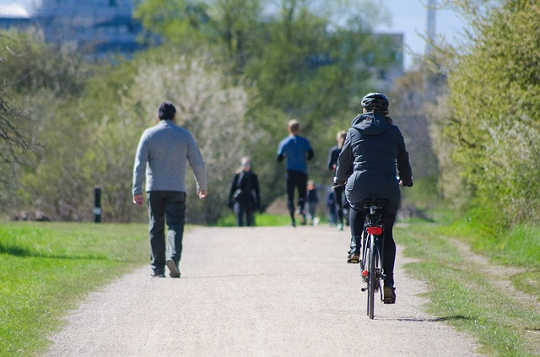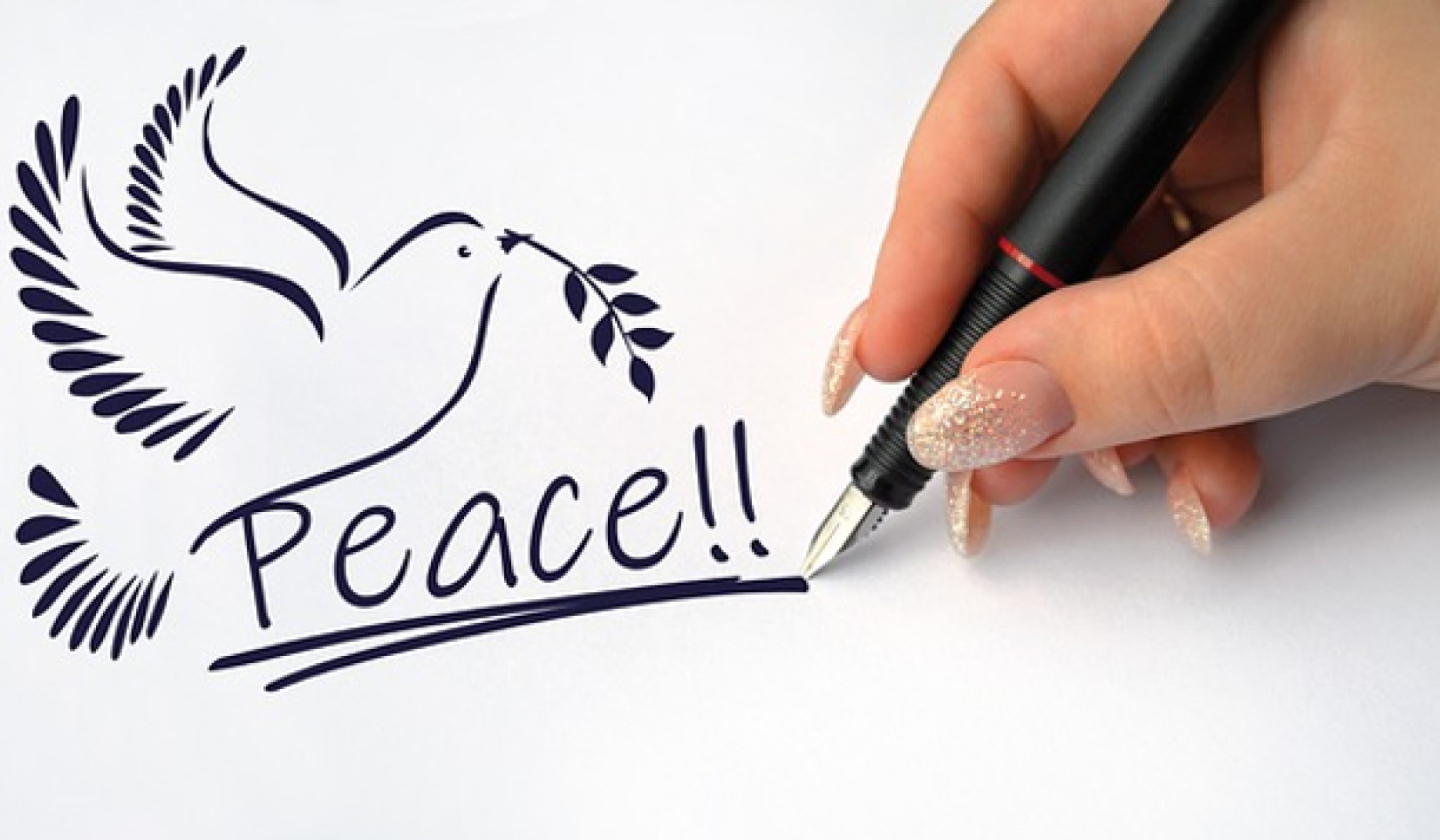
Human wellness is a daily phenomenon. The great life rhythms of land animals like ourselves—eating and fasting, sleeping and waking—follow a twenty-four-hour cycle that itself follows the sun.
Chronobiology, the science that studies such rhythms, has mapped out many such cycles in the mammalian brain and body. These include not only observable behaviors but physiologic patterns as well—predictable variations in heart rate, body temperature, and cell metabolism—and cyclic changes in the level of hormones such as cortisol and melatonin.
We humans are circadian creatures. Like the moon overhead and the ocean tides it governs, we live day-to-day on regular circuits of ebb and flow, departure and return.
When we’re suffering from PTSD, dailiness can feel like a great foe. We come to dread a twenty-four-hour cycle of poor sleep, exhausted waking, and hour upon hour set out like mile markers on a lost highway of fear, anger, and loneliness. As days of such living become months and even years, we can feel we’re living out a script invariant as that of an inmate serving a life sentence. Sunrise brings no joy, sunset no relief.
Yet when we’re resolved to establish new habits of body and mind, the brain’s predisposition toward dailiness becomes a great ally. An activity that occurs each day, especially one that happens at about the same time, becomes incorporated into our physical and mental schemas at both conscious and subconscious levels. We begin to accept that activity as a given and its influence spreads far beyond the time spent doing it.
Habitual Daily Behaviors
Most of what we do in any twenty-four hours is in fact habitual behavior. We get up at a certain time, which then triggers a predictable series of actions that carries us through our day. We don’t make a conscious decision to brush our teeth, weighing the pros and cons of this choice against other alternatives. We simply find ourselves at the bathroom sink, staring sleepily into the mirror and brushing. When we resolve to reset our lives from PTSD we are deciding to create new habits of body, heart, and mind that will carry us through our days in new ways.
Each new year, one in two U.S. citizens resolves to change some habit. One third of them vow to lose weight. Others promise to quit smoking, start exercising, or find true love.
Americans’ track record on actually resetting such behaviors is not good. Fewer than 10 percent follow through and achieve their goals. Twenty-five percent will throw in the towel by January 8.
Misunderstanding The Role Of Willpower
What causes most people to stumble? More than anything else, the problem is misunderstanding the role of willpower in initiating and maintaining new behavior. Let’s look together at this important point.
A prevailing cultural myth views brute willpower as the active ingredient in aligning our behavior with desired outcomes. Think of the maxims Just say no! Just do it!
This myth considers force of will a muscle one develops to take oneself in hand and move toward one’s goals. Often this prescription takes on moral overtones: “good” people act in accord with their stated goals and values. Such people “resist temptation” to fall into “vices” like inactivity, overeating, smoking cigarettes, and so forth.
There are two problems with this view. The first is that research data does not support it. Research shows that “effortful inhibition of impulses”—psychology’s description of “resisting temptation”—is negatively correlated with self-control and goal achievement.
Effortless Momentum Gets Better Results Than Effortful Inhibition
Highly successful people engage in far less effortful inhibition than do others. Rather than effortfully resisting, high achievers are carried effortlessly forward by force not of will but of habit. Habitual behavior carries them through their days like current on a river. They “just find themselves” brushing their teeth, exercising, eating well, working in productive ways, and so on.
The second problem with the force-of-will solution is that it sets us up in a power struggle with ourselves. A colleague refers to this as the “slave-driver dilemma.” We pick up a stick to drive ourselves in some direction we think we “should” go. But as our colleague notes, “The natural thing for a slave to do is to revolt!” So slave driving actually sets us up for failure.
Slave driving might get us a step or two down the road, but as is the case with 90 percent of New Year resolutionists, this approach soon backfires. When it does, we resume smoking, stop exercising, return to our familiar habits, and now have the new problem of feeling discouraged, guilty, and bad about ourselves.
Very often—in fact almost always—something in our environment triggers us and we are plunged back into the old ways of thinking, feeling, and acting. We tell ourselves relapse “proves” that we’re hopeless cases, that we “only thought” we’d gotten better, and that any further efforts in the directions we’ve been working would be pointless.
The Benefits Of Regular Practice
Many research studies have shown the more people work on themselves, the more they improve. A large study of more than one thousand yoga practitioners showed that greater frequency of yoga practice outside class correlated with greater well-being, better sleep, and less fatigue. A study on mindfulness meditation that included a yoga component showed the amount of practice was directly related to decreases in stress and increases in psychological well-being.
The benefits of regular practice extend far beyond improvements in mood and sleep. Regular yoga practice has been found to improve immune function. Researchers have also observed that the number of years of yoga practice correlated to a protective effect on age-related loss of grey matter in the brain.
Two studies have been done specifically addressing yoga practice for PTSD. In a follow-up PTSD study, women who continued to practice yoga for one and a half years had fewer symptoms and were less likely to be diagnosable with PTSD.
Participants in a Kundalini Yoga as taught by Yogi Bhajan program for PTSD considered home practice “critical” to the program’s success. Respondents expressed that “while initially a challenge to discipline oneself, the consistency, structure, and routine of having a self-healing practice that could be done anytime were vital to feelings of self-improvement and well-being.”
Can Do Attitude
“Self-efficacy,” a term coined by Stanford psychologist and former president of the American Psychological Association Albert Bandura, describes belief in one’s ability to complete tasks and reach goals. Bandura notes that changing old habits and acquiring new ones involves two expectations. One, we anticipate new behavior producing new effects in our lives. Two, we expect that we will actually carry out and sustain the new behavior.
Yet the notion of self-efficacy is much older than modern psychology. Nearly two thousand years ago the Indian sage Patanjali wrote in his Yoga Sutra that faith and energy are the first steps in reaching the “supraconscious ecstasy” that is the goal of yoga. Patanjali, too, speaks to the concept of self-efficacy: a belief we can achieve our goals produces the motivation to do so.
Self-efficacy is often examined in research studies. In one study breast-cancer survivors with greater self-efficacy were more likely to attend yoga classes. And because self-efficacy drives behaviors associated with better treatment outcomes, researchers have been looking at ways to develop and increase this human quality.
Such research suggests we can create positive-feedback loops in our lives. Practicing yoga we increase self-efficacy—which in turn supports yoga practice. This is exactly what happens with the Motivator tool: our behavior creates willingness to continue the new behavior. As we reap the rewards of this virtuous cycle—greater happiness, self-worth, better sleep, and so on—the new behavior becomes encoded in the brain as a self-reinforcing part of our habitual repertoire.
As Bandura noted, in concert with all of the above, one additional thing happens: we change our beliefs about ourselves. Old self-sabotaging beliefs like Things will never get better, I can’t do anything right, There’s no point in trying give way to new, life-promoting beliefs in our capacity to create lives worth living.
Belief is the ground from which all our thinking arises. Life-promoting beliefs produce new thought patterns, feelings, and habitual behavior that will increasingly carry us forward like current on a river toward all the destinations we would most like to reach. “Less and less do you need to force things,” the Tao Te Ching, a classic Chinese text of philosophical guidance, tells us. “When nothing is [forcefully] done, nothing is left undone.”
The Road Forward
The Old English term foreweard is the root of our word “forward.” Foreweard carried such meanings as “inclined to the front,” “early,” and “former.” We very much like these connotations. When we’re living out in front of our lives we’re not hiding behind anything. When we’re early in our living we’re not overthinking things or involved with security operations that emerge downstream of our negative thoughts. As a result we’re more spontaneous, open, ourselves. We might conceptualize trauma recovery as return to our former, pre-trauma selves.
Buddhism’s first noble truth is “Life is suffering.” All the great world paths give us their version of the declaration “Happiness is our birthright.” Such statements do not contradict each other: they are, rather, like two feet walking. Every hour of every day brings its form of suffering. Something doesn’t go our way. Someone says an unkind word. Our physical comfort or wellness is threatened in ways great or small.
Yet whatever the circumstances of our lives we have the possibility of using these to experience and deepen the happiness that is at the center of human living and dying.
We can consider cognition and physicality the walls, floor, and roof of our first home. What we think and how we carry ourselves through our days and nights provide the primary structure in which we live. Any structures farther away than this—our physical houses, nation states, and so on—are perhaps less influential in regard to our happiness than this first.
People with very little outside structure regularly live profoundly happy, meaningful lives. And people who seem from the outside to “have it all” are sometimes so unhappy they kill themselves. It seems the Greek Stoics had it right: it’s not what befalls us but what we tell ourselves that determines the quality of our human experience.
Any road forward is no other than the ground beneath our feet. We are, in fact, always already on the path.
©2018 by Julie K. Staples and Daniel Mintie.
Reprinted with permission of the publisher,
Healing Arts Press. www.InnerTraditions.com
Article Source
Reclaiming Life after Trauma: Healing PTSD with Cognitive-Behavioral Therapy and Yoga
by Daniel Mintie, LCSW and Julie K. Staples, Ph.D.
 Drawing on many years of clinical work and their experience administering the successful Integrative Trauma Recovery Program, the authors help readers understand PTSD as a mind-body disorder from which we can use our own minds and bodies to recover. Woven throughout the book are inspiring real-life accounts of PTSD recoveries showing how men and women of all ages have used these tools to reclaim their vitality, physical health, peace, and joy.
Drawing on many years of clinical work and their experience administering the successful Integrative Trauma Recovery Program, the authors help readers understand PTSD as a mind-body disorder from which we can use our own minds and bodies to recover. Woven throughout the book are inspiring real-life accounts of PTSD recoveries showing how men and women of all ages have used these tools to reclaim their vitality, physical health, peace, and joy.
Click here for more info and/or to order this paperback book (or the Kindle edition)
About the Author
 Daniel Mintie, LCSW, is a cognitive-behavioral therapist, researcher, and trainer with over 27 years’ experience healing trauma. Along with Julie K. Staples, Ph.D., he developed an Integrative Trauma Recovery Program combining yoga and cognitive-behavioral therapy for healing PTSD. Daniel lives in New Mexico and conducts mind-body wellness workshops at universities and training centers worldwide.
Daniel Mintie, LCSW, is a cognitive-behavioral therapist, researcher, and trainer with over 27 years’ experience healing trauma. Along with Julie K. Staples, Ph.D., he developed an Integrative Trauma Recovery Program combining yoga and cognitive-behavioral therapy for healing PTSD. Daniel lives in New Mexico and conducts mind-body wellness workshops at universities and training centers worldwide.
 Julie K. Staples, Ph.D., is the Research Director at the Center for Mind-Body Medicine in Washington, D.C., adjunct Assistant Professor at Georgetown University, and a certified Kundalini yoga teacher. Along with Daniel Mintie, LCSW, she developed an Integrative Trauma Recovery Program combining yoga and cognitive-behavioral therapy for healing PTSD. Julie lives in New Mexico and conducts mind-body wellness workshops at universities and training centers worldwide.
Julie K. Staples, Ph.D., is the Research Director at the Center for Mind-Body Medicine in Washington, D.C., adjunct Assistant Professor at Georgetown University, and a certified Kundalini yoga teacher. Along with Daniel Mintie, LCSW, she developed an Integrative Trauma Recovery Program combining yoga and cognitive-behavioral therapy for healing PTSD. Julie lives in New Mexico and conducts mind-body wellness workshops at universities and training centers worldwide.
Related Books
at InnerSelf Market and Amazon
























